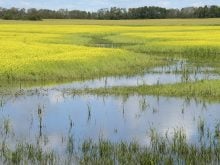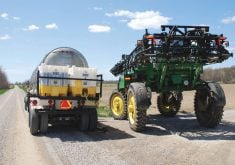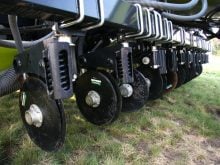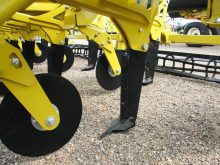Soil compaction can be a persistent challenge for farmers and, much like salinity, it starts with moisture.
“When the soil is dry — we have a nice, dry fall and are doing harvest — we’re not really causing a lot of issues,” said Marla Riekman, a soil management specialist with Manitoba Agriculture. “It’s when we are travelling on that field when it is moist where we can actually cause the most problems.”
There’s no way to eliminate field traffic, but more deliberate equipment and crop choice can limit compaction risk, soil experts say.
Read Also

VIDEO: Bittersweet harvest for this family farmhand
Bruce Burnett helps his brother harvest wheat and canola for the last time on the family farm in Manitoba where they both grew up.
Farmers sometimes have little choice but to get on the field, even when they know moisture is high enough to risk compaction.
Wet springs and spray seasons, such as this year, when conditions in Manitoba were wet enough that many missed their ideal herbicide window, often see farmers push the boundaries on field access.
Staying off the field during critical periods is best, Riekman noted, and being more deliberate with field traffic can reduce the risk.
“Wheel track compaction is probably one of the most severe things. We (have) traffic all over the place and cause a lot of damage by doing that.”
Around 80 per cent of soil compaction occurs during the first pass of equipment.
Riekman suggested consistently driving over the same paths. Dry harvest conditions aren’t the worst time for compaction, but it still includes deliberate travel with the grain cart or combine. Permanent tracks would be even better, she noted, but that might be hard to do.
“In the wet years when we’re kind of stressed out and things are a little bit more hectic … those are the years when you really have to have a good plan in place.”
Crop choice can also affect the risk of compaction. Heavy water users dry out soil, and crops with a taproot can push through compacted layers better than fibrous-rooted crops, although their effectiveness is limited, Riekman said.
“We have to recognize that a taprooted crop can only do so much or put so much pressure on the soil.”
She also cautioned against using tillage to deal with compaction unless conditions are ideal.
“While you could potentially deep rip and pull through that compaction layer, it needs to be very dry all the way to depth of tillage,” she said. Otherwise it might create an even worse problem.
She also noted the impact of axle load on heavy equipment. The heavier the equipment, the deeper that compaction goes into the ground, and today’s combines, grain carts and other equipment are very heavy.


















